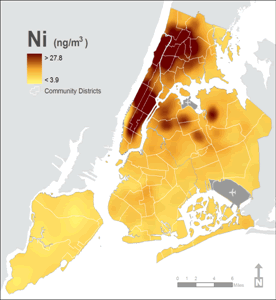 Second Air Quality Report Finds that Air Pollution from Nickel Varies Widely across the City
Second Air Quality Report Finds that Air Pollution from Nickel Varies Widely across the City
Manhattan and Bronx neighborhoods have the highest average levels of airborne nickel particles during winter months; boilers burning dirty fuel are a leading source of air pollution
 Airborne nickel concentrations vary widely across New York City during winter months, according to a new report on street-level air quality, and building boilers remain a major contributor of air pollutants. The Health Department released the new findings as a follow-up to the City's first report on wintertime air quality, which came out in December. The data come from the New York City Community Air Survey (NYCCAS), a year-round study of urban air quality launched in 2008 to help inform the City's efforts to reduce pollution. The new findings are the first to document variation in nickel concentrations during the winter season.
Airborne nickel concentrations vary widely across New York City during winter months, according to a new report on street-level air quality, and building boilers remain a major contributor of air pollutants. The Health Department released the new findings as a follow-up to the City's first report on wintertime air quality, which came out in December. The data come from the New York City Community Air Survey (NYCCAS), a year-round study of urban air quality launched in 2008 to help inform the City's efforts to reduce pollution. The new findings are the first to document variation in nickel concentrations during the winter season.
The findings support results from the first NYCCAS report, demonstrating that residual fuel oil used for indoor heating contributes significantly to harmful air pollution in the city. Nickel is one of several metals found in air particles released from the combustion of this type of fuel. The inhalation of these fine particles can irritate lungs, worsen asthma and emphysema, and increase the risk of heart attacks and premature death.
The report, "Nickel Concentrations in Ambient Fine Particles: Winter Monitoring, 2008-2009," estimates that nickel levels are higher in more built-up parts of the city, including much of Manhattan and parts of the Bronx with more large buildings that burn residual oil (#4 or # 6) in boilers used to produce heat and hot water. Residual oil has higher nickel concentrations. As a result, airborne nickel levels in these areas are nearly four times the levels found in areas with fewer residual oil burners. Similarly, densely populated residential areas have three times the nickel levels found in areas where residential population is lower.
"All New York Yorkers, and especially those with heart and lung disease, have a stake in improving the City's air quality," said Dr. Thomas Farley, New York City Health Commissioner. "New Yorkers banned coal furnaces decades ago, as the health impact became clear. The time has come to phase out residual oil for the same reason."
The study expands the evidence that residual oil, which contains high levels of sulfur and other metals in addition to nickel, is a significant source of fine-particle air pollution, also known as PM2.5. Seniors and young children may be especially vulnerable to air pollution, but it affects everyone. In a national study published last year, researchers found that residents in cities with poorer air quality had shorter average life expectancies. Cities that achieved larger reductions in fine-particle air pollution during the 1980s and 90s enjoyed greater health gains during those decades.
"Emissions from oil burning equipment can significantly affect air quality," said NYC Environmental Protection Commissioner Cas Holloway. "The Department of Environmental Protection routinely inspects sites with a team of 45 inspectors who perform tests to ensure that we are protecting public health. This report clearly indicates that we need further reductions in residual oil emissions to address the harmful health impacts of these pollutants."
"Today's report demonstrates that dirty heating oil is a major source of air pollution that is directly affecting New Yorkers' health," said Rohit T. Aggarwala, the City's Director of Long-Term Planning and Sustainability. "We cannot accept that this is just the normal course of business when there are so many alternatives available to building owners, including clean number 2 oil, natural gas and bioheat."
The report, available at nyc.gov/health , suggests that careful maintenance can help reduce emissions from existing boilers, but longer-term measures should also include retrofitting residual oil boilers or replacing them with equipment that burns natural gas or #2 heating oil - alternative heating fuels that produce much less PM2.5. Because nickel levels fluctuate during the year, future NYCCAS reports will measure concentrations during other seasons to determine annual averages for different parts of the city.
About the New York City Community Air Survey
In 2007, New York City's first comprehensive sustainability plan, PlaNYC, established a range of initiatives to improve the City's air quality. One PlaNYC initiative, the New York City Community Air Survey is studying how harmful air pollutants vary across New York City neighborhoods. Launched in December 2008, NYCCAS is sampling the air at 150 street-level locations (figure 1) in every season to help inform the City's air quality improvement efforts.
The sampling began during the winter of 2008-2009, and the first findings were published in a December 2009 report . The report showed that concentrations of four pollutants -- fine particles (PM2.5), elemental carbon (EC), nitrogen dioxide (NO2) and sulfur dioxide (SO2) -- varied two-fold or more across the city. Concentrations were higher in areas where fuel combustion sources, especially on-road vehicles and buildings -- are more abundant.
Data from the survey will help to inform air-quality initiatives in the next edition of PlaNYC, to be published in 2011. New York City's second round of sustainability planning, like the initial PlaNYC, will involve the community in developing these initiatives. To learn more about other New York City air-quality initiatives, visit www.nyc.gov .
###
